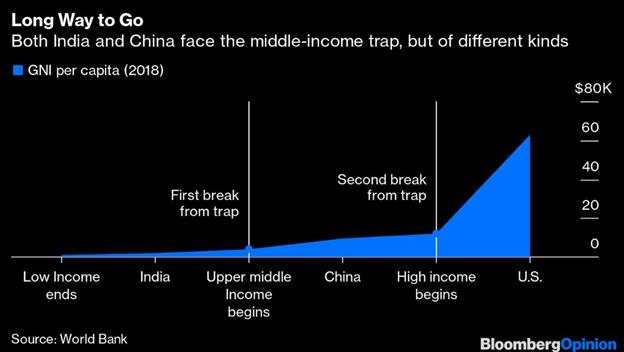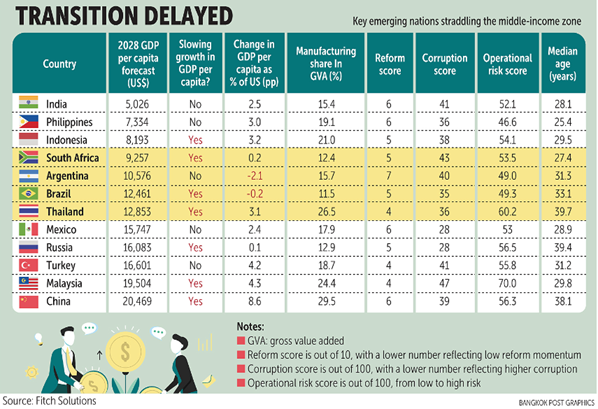Middle-Class Boom Breaks Income Trap
Relevance
- GS Paper 3 Indian Economy and issues relating to Planning, Mobilization of Resources, Growth, Development and Employment.
- Tags: #Middleincometrap #middleclass #Liveminteditorial #UPSCMains2024.
Why in the News?
India’s rapidly growing middle class is expected to drive consumption growth and economic development. However, avoiding a middle-income trap requires addressing structural challenges and promoting investments in education and human resources.
India’s Middle Class: A Historical Evolution
- India’s middle class began taking shape during British colonial rule in the 19th century, playing a pivotal role in the nation’s struggle for independence.
- Today, it stands as the fastest-growing segment of India’s population, expanding at a remarkable 6% annually, in contrast to the matured middle classes in Europe and the US, which grow at less than 1%.
- India’s middle class is expected to grow at a rapid pace in the future, partly because a large proportion of its households earn slightly less than the global average.
- The lower end of this spectrum, with households earning under ₹1 lakh per year, is expected to grow faster than the upper end.
- Currently representing 31% of India’s population, it’s projected to reach 40% by 2031.
- This growth potential is substantial, driven by the significant income gap between India and developed nations and India’s youthful demographic in a globally aging context.
Middle Class Fueling India’s Consumption-Led Economic Growth
- India’s expanding middle class is a key driver of consumption growth, spurring rapid economic development.
- Global tech giants are investing heavily in India, attracted by its vast and swiftly expanding consumer market.
- New middle-class households in India purchase more consumer durables than their counterparts in Europe and the US, driving increased demand for items like cars and refrigerators.
India’s Demographic Dividend: A Catalyst for Economic Growth
- India’s favorable demographic trend, characterized by a growing working-age population and increased female labor force participation, paves the way for an expanding middle class.
- This demographic advantage, combined with a rising number of people who can both purchase and save, offers a pathway to mitigate the capital-intensive nature of industrialization and the costs associated with international trade.
- India’s burgeoning middle class has the potential to create a virtuous cycle, driving income growth, increased savings, higher investments, and overall economic prosperity.
- However, despite this promising trajectory towards a middle-class society, there is a looming concern of falling into a middle-income trap.
- China’s slowdown and the challenges faced by several East Asian economies in reaching high-income status after rapid growth serve as cautionary examples.
Why Countries fall into Middle Income Trap?
First – Struggles of developing countries
- Numerous developing countries advance from low to middle income but struggle in a middle-income trap.
- They compete with low-wage producers while lacking the innovation of highly skilled nations, stalling growth.
Second – Structural shift
- When a country shifts its economy from one sector to another, or deliberately rebalances its growth drivers, it risks falling into the middle-income trap.
- This trap occurs when a country’s per capita income stagnates, despite economic growth.
- China is facing this risk today as it shifts from manufacturing to faster-growing services industries.
- The risk is higher for countries that lack innovation capabilities, which are needed to shift production to higher value-added goods or services.
- Two frequent mistakes that many middle-income nations tend to make are either sticking too tightly to previous successful policies or pulling out of industries that may have provided a foundation for specialization too quickly.
- A seamless transition depends on timing.
Third – Rising Income Inequality
- Increasing income inequality, as seen in India where the wealthiest 1% owns over 40% of the wealth while the bottom 50% shares only 6%, poses a risk of falling into a middle-income trap.
- Technological shifts favoring higher-level skills intensify wage disparities.
- As income inequality grows, it constrains consumer spending among the less affluent, hindering economic progress.
What policymakers can do?
First – Balancing Middle-Class Growth and Demographic Dividend
- India’s middle class and demographic dividend can align for mutual benefit.
- To seize this opportunity, substantial investments in physical and human resources are required.
- While India has emphasized physical infrastructure, it lags in human capital investments, particularly in education and skills.
- The youthful population isn’t adequately equipped for the economy’s skill requirements.
Second – Enhancing Education: A Holistic Approach
- Improving education for all in India necessitates a holistic strategy.
- It involves ensuring students are ready to learn, addressing issues like malnutrition and stunting.
- Prepared teachers and institutions that prioritize learning, with aligned incentives, are crucial.
- The most significant challenge is coordinating all system stakeholders.
- The goal is a well-educated workforce, easily adaptable to evolving job requirements.
Third – Middle Class Demands and Public Services
- As the middle class grows, expectations for better public services increase.
To meet this demand, innovative solutions are necessary, including public-private partnerships and global collaboration. The government alone may struggle to provide the quantity and quality required, making collaboration vital for addressing these challenges.
|
Middle-Income Trap
Signs of the middle-income trap
Recent Examples
|
Source: Livemint
Mains Question
What is the middle-income trap, and why do many countries face the risk of getting caught in it? Explain the common mistakes made by middle-income countries in their growth strategies and how India can avoid falling into this trap.





